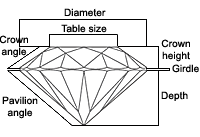Diamond Cut
| |
| |
(See Diamond Anatomy for an explanation of the terms used in the next paragraphs.)
As shown in the images below, when a diamond is well-cut, light enters through the table and travels to the pavilion where it reflects from one side to the other before reflecting back out of the diamond through the table and to the observer's eye. This light is the brilliance we mentioned, and it's this flashing, fiery effect that makes diamonds so mesmerizing.




Most gemologists agree that the best cut diamonds are those that follow a set of formulae calculated to maximize brilliance. These formulae can be seen in a diamond's proportions, most importantly how the depth compares to the diameter, and how the diameter of the table compares to the diameter of the diamond.
| |
Because cut is so important, several grading methods have been developed to help consumers determine the cut of a particular diamond. In general, these grades are:
- Ideal
- Premium
- Very Good
- Good
- Fair & Poor
Selecting the grade of cut is really a matter of preference. To make the best selection, you need to understand the various grades. Please note that the descriptions below are general guidelines. Ideal Cut
This cut is intended to maximize brilliance, and the typically smaller table sizes of these diamonds have the added benefit of creating a great deal of dispersion or 'fire' as well. Ideal quality diamonds are truly for the person who enjoys knowing that he has one of the finest things that money can buy. This category applies only to round diamonds.
Premium
In the case of round diamonds, many Premium Cut diamonds have cuts that are the equal of any Ideal Cut diamond, though they often can be purchased at slightly lower prices than AGS Ideal Cuts. They are intended to provide maximum brilliance and fire. Like the Ideal Cut, these are also for the person who enjoys knowing that he has one of the finest things that money can buy.
Very Good
These diamonds reflect most of the light that enters them, creating a good deal of brilliance. With these diamonds, the cutters have chosen to stray slightly from the preferred diamond proportions in order to create a larger diamond. The result is that these diamonds fall slightly outside of some customers' preferences in terms of, for example, table size or girdle width, though, in many cases many of the parameters of diamonds in this range will overlap with certain parameters of diamonds in the Ideal or Premium ranges. Generally, the price of these diamonds in slightly below that of Premium cuts.
Good
Diamonds that reflect much of the light that enters them. Their proportions fall outside of the preferred range because the cutter has chosen to create the largest possible diamond from the original rough crystal, rather than cutting extra weight off to create a smaller Premium quality diamond. Diamonds in this range offer an excellent cost-savings to customers who want to stay in a budget without sacrificing quality or beauty.
Fair & Poor
A diamond graded as fair or poor reflects only a small proportion of the light that enters it. Typically these diamonds have been cut to maximize the carat weight over most other considerations.
Diamond Anatomy
Wondering what on earth is the diamond's pavillion? Table? Culet? The graphic and supporting text below explain the various "parts" of a diamond.

- Diameter
The width of the diamond as measured through the girdle. - Table
This is the large, flat top facet of a diamond. - Crown
The upper portion of a cut gemstone, above the girdle. - Girdle
The narrow rim of a diamond that separates the crown from the pavilion. It is the largest diameter to any part of the stone. - Pavilion
The lower portion of the diamond, below the girdle. It is sometimes referred to as the base. - Culet
The tiny facet on the pointed bottom of the pavilion, which is the portion of a cut gem below the girdle. - Depth
The height of a gemstone, from the culet to the table.
No comments:
Post a Comment